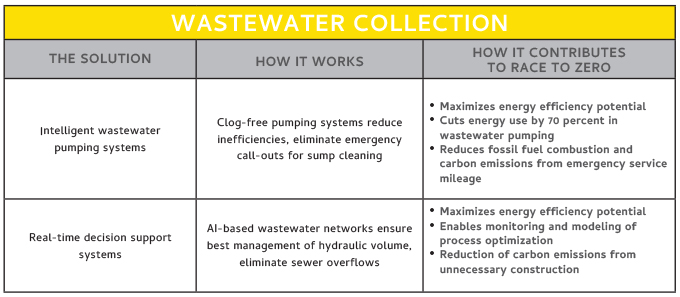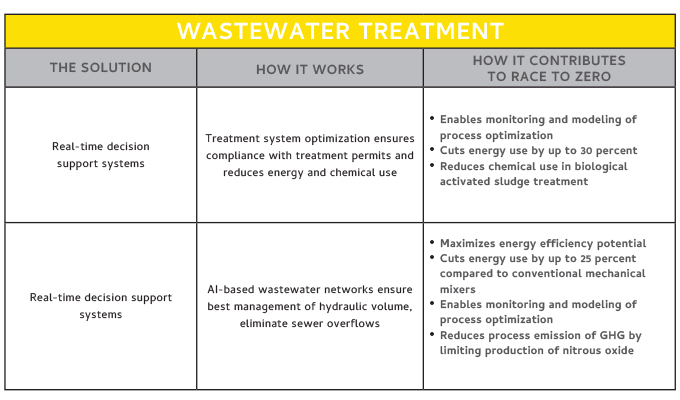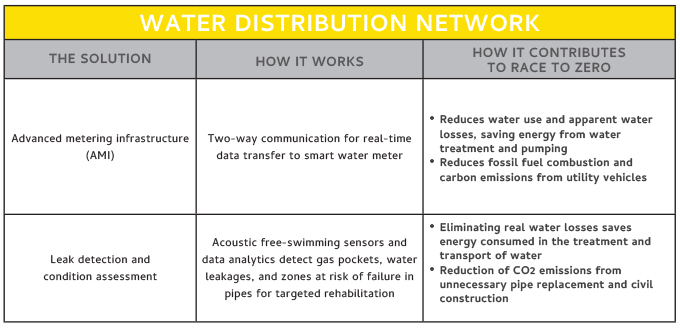Water operators have long been stewards of an essential resource, and water infrastructure is a cornerstone of every prosperous economy. But today’s water systems are also major sources of global greenhouse gas (GHG) emissions. Water utilities account for approximately 2 percent of GHG emissions—the equivalent of the world’s shipping industry. And this figure is set to spiral as utilities work towards the United Nations’ Sustainable Development Goal of universal access to water and sanitation by 2030.
Assessments by Xylem and our partners indicate utilities could dramatically reduce electricity- and process-related GHG emissions across water and wastewater infrastructure—quickly and cost-effectively—using existing, high-efficiency technologies. A growing number of utility operators are committing to “net-zero” emissions targets, along with detailed route-maps to achieve them. Efficient technologies—together with changes in process, policy and practice—can drive rapid progress without adding costs to current operations.
By embracing these opportunities today, utilities can free up capital to fund water and wastewater infrastructure upgrades at the same time as they reduce their GHG emissions. As a sector built on serving communities and protecting the environment, it is time for water to take its place in the greater climate discussions—and lead the way with action. The water sector could become one of the fastest sectors to decarbonize, and a powerful example to others. This paper outlines some of the ways utilities can get started on their race to zero.

DECARBONIZING THE WATER SECTOR AT NEUTRAL TO NEGATIVE COST
Xylem’s initial study of wastewater infrastructure, “Powering the Wastewater Renaissance,” assessed eighteen distinct electricity related emissions abatement opportunities across three regions: the United States, Europe, and China. Core findings from this study, and from a follow-up analysis of the clean water sector, include:
- 50 percent of energy-related emissions from the wastewater sector can be abated with existing technologies, such as intelligent wastewater pumping systems, adaptive mixers with variable speed drives, and real-time decision support systems. According to a Water UK report, 95 percent of the impact is achievable at zero or negative cost.
- Reduction of energy-related emissions in the wastewater sector is directly related to the pace of adoption of existing technologies. It does not require new technologies or carbon pricing policies.
- Existing technologies can also reduce process emissions. For example, intelligent mixing and aeration systems enable monitoring and modeling that can reduce process-related GHG emissions by limiting production of nitrous oxide.
- In clean water, readily deployable high efficiency technologies also have a material impact on emissions reduction. Technologies such as ultraviolet (UV) disinfection and advanced metering infrastructure (AMI) deliver significant emissions abatement throughout the water production plant and the water distribution network.
- Infrastructure decisions made today will have consequences for decades to come. While there is investment and research still required to advance the sector’s ability to eliminate emissions, particularly in regard to process emissions, the technology and solutions exist today to make meaningful impact. In the United Kingdom alone it is estimated that utilities could save up to 10 million tons of greenhouse gas by reaching net zero in 2030.

LEADING UTILITIES ARE MAKING SWIFT PROGRESS TOWARD NET ZERO, TODAY
Water utilities around the world are already setting firm net-zero targets—and beginning to deliver on them. For example, water companies in the UK have almost halved operational emissions since 2011 through a combination of energy efficiency measures, renewable energy and the production of biomethane from sewage treatment processes.
In the United States, the city of Gresham’s wastewater treatment plant is the first in the Pacific Northwest to generate more electricity than it consumes each year through the use of biogas generation and recovery, saving the city about $500,000 per year. These experiences demonstrate that by prioritizing emissions reduction, water operators can deliver big results quickly, affordably, and at minimal risk.
As of October 2021, Global Water Intelligence identified 65 water and wastewater utilities with net-zero, carbon, and climate neutrality targets. They include some of the largest utilities in the world, serving over 185 million people. From Melbourne Water to the Metropolitan Water District of Southern California and Thames Water in the United Kingdom, utilities across geographies are increasing their accountability on the path to net zero.
Innovative approaches are fueling progress. As part of its strategy to achieve net-zero emissions by the middle of this century, PUB, Singapore’s national water agency, plans to award $4.82 million to incentivize innovative solutions that can eliminate carbon emissions from water treatment facilities. The agency is seeking carbon capture, utilization, removal, and other solutions at any technology readiness level that can be integrated with its operations and reach commercial scale within a decade or sooner.
The opportunity is clear. The components of success are available: technologies, experience, funding, collaboration and, increasingly, regulatory incentives.

GETTING OUT OF THE GATES FAST: HOW TO MAKE A QUICK START REDUCING EMISSIONS
The faster water utilities deploy these high-efficiency technologies, the faster emission targets are achieved, contributing to the containment of climate change. Here are some steps that can help accelerate water utilities’ race to zero:
- Make Firm Commitments to Reduce Emissions
Leading utilities are already joining the water sector’s race to zero. Led by the United Nations’ High-Level Climate Champions for Climate Action, the race to zero is a global initiative, rallying companies, cities, and regions to take immediate action to halve global emissions by 2030 and deliver a healthier, fairer zero-carbon world in time. - Deploy High-efficiency Technologies to Make Meaningful, Early Progress—Affordably
For example, intelligent wastewater pumping systems can cut energy use by up to 70 percent in wastewater pumping by reducing inefficiencies and emergency call-outs associated with clogging. In clean water, leak detection technologies can eliminate real water losses, saving energy consumed in the treatment and transport or water. - Define the Supporting Processes, Policies, and Practices to Reach Net Zero
Water UK’s net zero 2030 route-map details the broad range of approaches that are required to deliver on this commitment and provides specific actions to create accountability, reduce the costs and risks of the transition to net zero, and to unlock new benefits.

CONCLUSION
By implementing high-efficiency technologies and making emissions focused changes to operational processes and practices, water utilities can win the race to zero, while delivering the essential services on which their communities’ health and prosperity depend. High-efficiency technologies, including digitally-enabled solutions, are helping utilities realize dramatic emissions reductions across both clean water and wastewater activities.
By Austin Alexander, Xylem
FOR MORE INFORMATION
Austin Alexander is Xylem’s chief sustainability officer. Xylem is a leading global water technology company committed to solving critical water and infrastructure challenges with innovation. Xylem’s more than 16,000 diverse employees delivered revenue of $4.88 billion in 2020. Xylem is creating a more sustainable world by enabling its customers to optimize water and resource management, and helping communities in more than 150 countries become water-secure. For more information, visit www.xylem.com.
MODERN PUMPING TODAY, January 2022
Did you enjoy this article?
Subscribe to the FREE Digital Edition of Modern Pumping Today Magazine!



